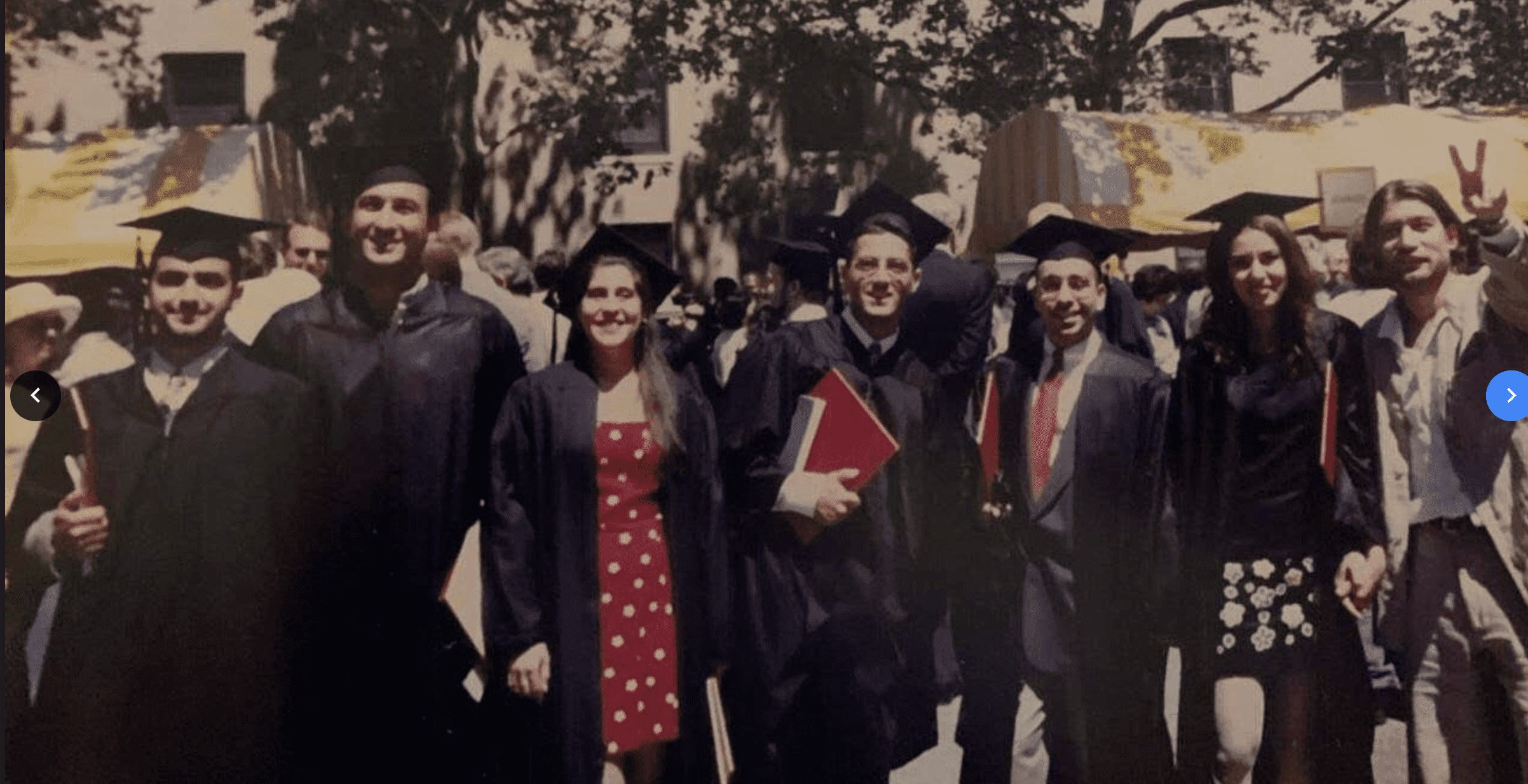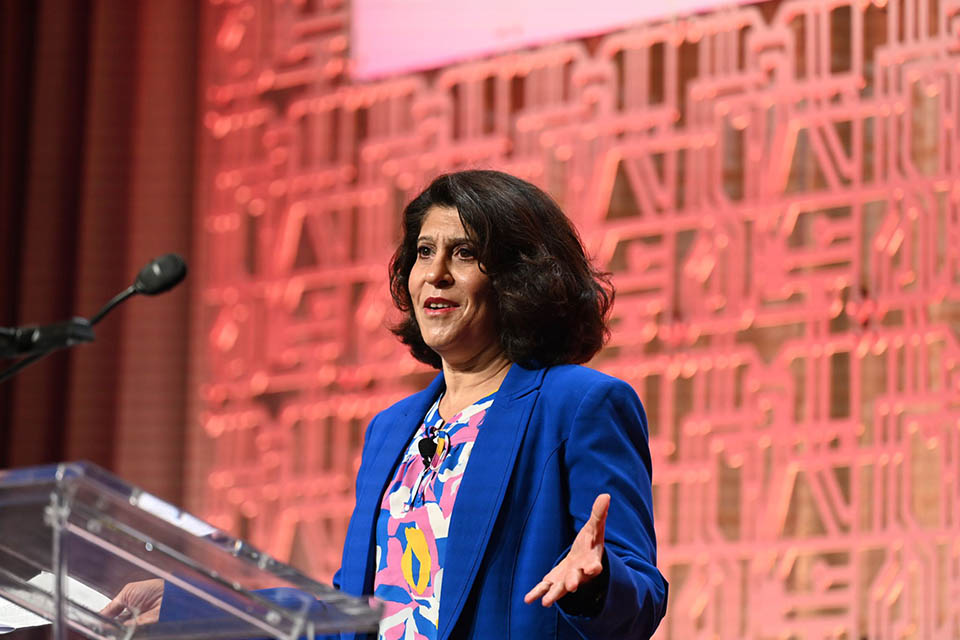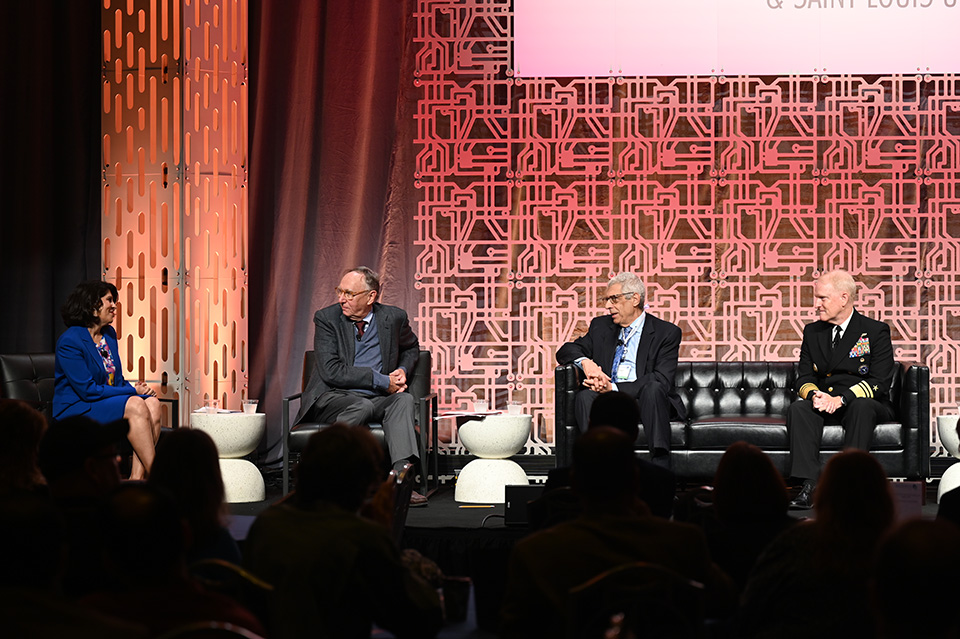A Conversation with Nadine Alameh: A Geospatial Journey Marked by Courage
Nadine Alameh, Ph.D. is the inaugural executive director of the Taylor Geospatial Institute (TGI). Here, she reflects on key moments from her life that brought her to this new position and made her a world-renowned geospatial expert.Nadine Alameh, Ph.D., was a mere toddler in 1975 when civil war broke out in her native Lebanon. A bloody conflict between different religious and political factions within and outside the country dragged on for years, transforming Beirut from a cosmopolitan capital (some referred to it as the Paris of the Middle East) into a scarred battlefield where bombs fell and bullets flew daily.
For the first 22 years of Alameh’s life, she, her brother, and her sister survived the daily challenges of a war zone. As children, they were shuttled by their single mother from temporary home to temporary home — trying to wrest some semblance of normalcy from the chaos of their surroundings. Some nights they would sleep on the beach, others they would find refuge at a friend’s home. Alameh recalled one particularly jarring memory as her mother, Nada, drove the family through the treacherous streets of Beirut: “She had a VW Beetle. She put us in the back and put stuff on top of us. You could hear not just the bombs, but also the snipers,” Alameh remembered. “And she said, ‘If the car stops, you stay there. Because it means I got shot. You stay there, and if you don’t hear anything, then you just keep going.’”

Even as she navigated this peripatetic and traumatic early life, Alameh managed to excel in school, often using books as a refuge to escape the horrors of her reality. When she was 18, Alameh applied for a position in the highly competitive computer engineering program at the American University of Beirut. She not only passed the entrance exam, she scored in the top seven of all applicants and received a full scholarship even though she’d never seen a computer up to that point in her life.
The courage that saw Nadine Alameh through the extremely difficult circumstances of her early life in Beirut has been a hallmark of her career ever since. As she continually sought out challenges and excelled in fields that were foreign to her, Alameh has emerged as a leading thinker in the field of geospatial science.
When she was an undergraduate student in Beirut, Alameh said that one of her instructors encouraged her to apply for a scholarship to attend graduate school at Massachusetts Institute of Technology (MIT), even though she had no desire for such a long-distance move. “I never wanted to go anywhere because I didn’t want to leave my mom and my sister and my brother,” Alameh said. But she did apply for one of the four MIT scholarships, and she won. Alameh was randomly assigned to the master’s program in urban planning with a concentration in geographic information systems (GIS), a tool for visualizing and analyzing spatial data. This would be her introduction to geospatial science.
During her graduate program, which she started in 1995, Alameh interned at MIT’s Intelligent Transportation Systems Lab, where researchers were creating geospatial simulations of the “Big Dig,” a massive infrastructure project to build a tunnel that rerouted Interstate 93 through the heart of Boston. Her advisor in that lab suggested that, with a few extra classes, Alameh might obtain a Ph.D. in addition to her master’s. She followed the advice and emerged from MIT in 2001 with a doctorate in information systems engineering in addition to two master’s degrees: one in civil engineering and one in city planning.

Through her graduate school experience at MIT, Alameh said she developed a sense for the all-encompassing nature of geospatial science. Everything happens in space and time,” Alameh said. “This is the starting point. But also, there’s the spatial relationships of things that give you a whole new insight into anything.”
Alameh continued to hone her expertise in the emerging field of geospatial science as she secured various positions after grad school: as a project manager for a company that did contract work for NASA; as senior technical advisor to NASA's Applied Science Program's Geoscience Interoperability Office (GIO) mission; as the president of MobiLaps LLC, a software technology and professional services company; as CEO of software company Snowflake Software; and as chief architect of Innovations and Technology Strategy at giant aerospace firm Northrop Grumman. Starting in 2019, Alameh served as the CEO and president of the Open Geospatial Consortium (OGC), a concentration of more than 500 industry, government, research, and academic organizations that strive to make location information “FAIR (Findable, Accessible, Interoperable, and Reusable).” During her tenure as head of OGC, Alameh also served as a member of the U.S. Department of the Interior’s National Geospatial Advisory Committee and as a board member of the United Nations Global Geospatial Information Management private sector network.

Throughout her journey in geospatial science, Alameh has made a point of building the field and increasing the ability of underrepresented groups to access it. Since 2022, she has been a board member of LebNet, a nonprofit focused on enabling tech entrepreneurs and professionals of Lebanese descent to succeed on a global stage. And in 2019, Alameh became the first ever Leadership in Diversity Award Recipient at GoGeomatics Canada’s GeoIgnite Conference. In early 2023, she won the 24th Annual Women in Technology Leadership Award in the Non-Profit and Academia category. Alameh said that her approach of fueling geospatial science and technology while simultaneously championing diversity and women in STEM fields is one of the reasons she chose to come to the Taylor Geospatial Institute (TGI) as its inaugural executive director in September 2023. “There’s a bigger mission here than geospatial,” she said. “It’s helping the society, which is what we should really all be doing after all.”
Alameh also noted that she has had a front-row seat to a remarkable evolution in geospatial science, from desktop GIS to web GIS to web services to cloud computing to the growth of Earth observation to autonomous everything to artificial intelligence/machine learning to 3D and digital twins and now video gaming.
“Geospatial science has expanded into more markets that can fit on a piece of paper,” Alameh said. “This is the energy of geospatial, this is the energy of TGI.”
At the helm of TGI, she expressed her goal to steer the young organization into a bright future as the central node of a thriving geospatial ecosystem taking shape in the St. Louis region. “There’s no shortage of opportunities in geospatial. We can do many things and be successful and have the consortium and keep everybody happy,” she said. “But that’s not enough, at least for me. I want TGI to be known for its impact not only on geospatial but also on society and the planet. That’s the big idea.”
Established by a legacy investment from Andrew C. Taylor, and led by Saint Louis University, TGI is a consortium of eight research and academic institutions including the Donald Danforth Plant Science Center, Harris-Stowe State University, the University of Illinois Urbana–Champaign, Missouri University of Science & Technology, the University of Missouri, the University of Missouri–St. Louis and Washington University in St. Louis. Together the consortium houses more than 100,000 students and 5,000 faculty, hundreds of whom are engaged in geospatial science and technology. Already, TGI has inventoried the geospatial expertise across this sprawling consortium and identified several application areas where researchers are applying emerging and exciting geospatial tools and thinking. These tools include artificial intelligence/machine learning, geoinformatics, and remote sensing, and the challenges to which these methodologies are applied run the gamut, from health and agriculture to environment and national security.

With no shortage of raw material in the TGI consortium in terms of talent, expertise, and research excellence, Alameh said that an eventual goal is to position TGI as a hub of geospatial science that can not only characterize the dynamic world we inhabit but help predict what changes might be coming our way. “So you come to TGI for the, ‘What’s going to happen in 50 years? What’s going to happen in 100 years?’” she noted. “So not analytics today, but actually to anticipate the future.”
As a new war gripped the Middle East in the fall and winter of 2023, Alameh was forced to relive the trauma of her early life in Beirut even as she delighted in the promise of her new role at TGI. “For the first week [of the Israel-Hamas War] I could not sleep,” she said. “I see the bombs again when I sleep, because that’s what I see on the news.”
But as she has throughout her life, Alameh will marshal on and face new challenges with hope, focus, and above all, courage.
“I’m proud that I built on every move every time, consistent with who I am, which is taking what I know and trying something new,” Alameh said. “I like that when I look back, it’s like: This is crazy, but I had the courage somehow.”
Story by Bob Grant, executive director of communications for the Taylor Geospatial Institute.
This piece was written for the 2023 SLU Research Institute Annual Impact Report. The Impact Report is printed each spring to celebrate the successes of our researchers from the previous year and share the story of SLU's rise as a preeminent Jesuit research university. More information can be found here.

















